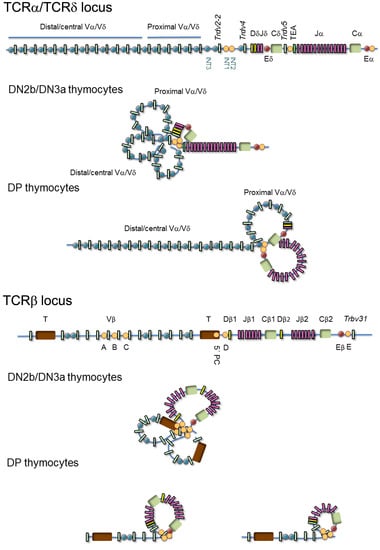Regulation of T-cell Receptor Gene Expression by Three-Dimensional Locus Conformation and Enhancer Function
Abstract
1. Signaling and TCR Expression during Thymocyte Development
2. TCR Genes
3. V(D)J Recombination Control during Thymocyte Development
4. Architectural Changes at the TCR Regions during Thymocyte Development
4.1. Topological Gene Changes at the TCRα/TCRδ and TCRβ V Regions
4.2. Topological Gene Changes at the TCRδ, TCRα, and TCRβ (D)-J Regions
5. TCR Enhancers and Function
6. Signaling-Dependent Control of TCR Enhancers during Thymocyte Development
7. Concluding Remarks
Author Contributions
Funding
Conflicts of Interest
Abbreviations
| 3C | Chromosomal conformation capture |
| 3D | Three dimensional |
| APC | Antigen presenting cell |
| β2m | >β2 microglobulin |
| bp | Base pairs |
| C | TCR gene constant region |
| Cα | TCRα gene constant region |
| Cβ | TCRβ gene constant region |
| Cδ | TCRδ gene constant region |
| Cγ | TCRγ gene constant region |
| CBS | CTCF binding site |
| CDR | Complementarity-determining region |
| CTCF | CCCTC-binding factor |
| D | Diversity (gene segment) |
| DN | Double-negative |
| DP | Double-positive |
| Eα | TCRα enhancer |
| Eβ | TCRβ enhancer |
| Eδ | TCRδ enhancer |
| eDP | Early DP |
| Eγ | TCRγ enhancer |
| HSC | Hematopoietic stem cell |
| IgH | Immunoglobulin heavy chain |
| IL-7R | Interleukin 7 receptor |
| ISP | Immature Simple positive |
| J | Joining (gene segment) |
| lDP | Late DP |
| MHC | Major histocompatibility complex |
| MHC-I | MHC class I |
| MHC-II | MHC class II |
| PAX5 | Paired box protein 5 |
| pTα | Pre-T α |
| RAG | Recombination activating gene |
| RC | Recombination center |
| RSS | Recombination signal sequence |
| SP | Simple positive |
| TCR | T-cell receptor |
| TEA | T early α exon exon |
| TEAp | TEA promoter |
| TF | Transcription factor |
| V | Variable (gene segment) |
| YY1 | Yin-Yang protein |
References
- Smith-Garvin, J.E.; Koretzky, G.A.; Jordan, M.S. T cell activation. Annu. Rev. Immunol. 2009, 27, 591–619. [Google Scholar] [CrossRef]
- Luoma, A.M.; Castro, C.D.; Adams, E.J. γδ T cell surveillance via CD1 molecules. Trends Immunol. 2014, 35, 613–621. [Google Scholar] [CrossRef]
- Huang, J.F. TCR-mediated internalization of peptide-MHC complexes acquired by T cells. Science 1999, 286, 952–954. [Google Scholar] [CrossRef]
- Vantourout, P.; Hayday, A.C. Six-of-the-best: Unique contributions of γδ T cells to Immunology. Nat. Rev. Immunol. 2013, 13, 88–100. [Google Scholar] [CrossRef]
- Yui, M.A.; Rothenberg, E.V. Developmental gene networks: A triathlon on the course to T cell identity. Nat. Rev. Immunol. 2014, 14, 529–545. [Google Scholar] [CrossRef]
- Taghon, T.; Yui, M.A.; Pant, R.; Diamond, R.A.; Rothenberg, E.V. Developmental and molecular characterization of emerging β- and γδ-selected pre-T cells in the adult mouse thymus. Immunity 2006, 24, 53–64. [Google Scholar] [CrossRef]
- Brekelmans, P.; Van Soest, P.; Voerman, J.; Platenburg, P.P.; Leenen, P.J.; Van Ewijk, W. Transferrin receptor expression as a marker of immature cycling thymocytes in the mouse. Cell. Immunol. 1994, 159, 331–339. [Google Scholar] [CrossRef]
- Radtke, F.; Fasnacht, N.; Macdonald, H.R. Notch signaling in the immune system. Immunity 2010, 32, 14–27. [Google Scholar] [CrossRef]
- Taghon, T.; Waegemans, E.; Van De Walle, I. Notch signaling during human T cell development. Curr. Top. Microbiol. Immunol. 2012, 360, 75–97. [Google Scholar] [CrossRef]
- Van De Walle, I.; Waegemans, E.; De Medts, J.; De Smet, G.; De Smedt, M.; Snauwaert, S.; Vandekerckhove, B.; Kerre, T.; Leclercq, G.; Plum, J.; et al. Specific Notch receptor–ligand interactions control human TCR-αβ/γδ development by inducing differential Notch signal strength. J. Exp. Med. 2013, 210, 683–697. [Google Scholar] [CrossRef]
- Ciofani, M.; Schmitt, T.M.; Ciofani, A.; Michie, A.M.; Çuburu, N.; Aublin, A.; Maryanski, J.L.; Zúñiga-Pflücker, J.C. Obligatory role for cooperative signaling by pre-TCR and Notch during thymocyte differentiation. J. Immunol. 2004, 172, 5230–5239. [Google Scholar] [CrossRef] [PubMed]
- Lauritsen, J.P.H.; Haks, M.C.; Lefebvre, J.M.; Kappes, D.J.; Wiest, D.L. Recent insights into the signals that control-lineage fate. Immunol. Rev. 2006, 209, 176–190. [Google Scholar] [CrossRef] [PubMed]
- Rodríguez-Caparrós, A.; García, V.; Casal, Á.; López-Ros, J.; García-Mariscal, A.; Tani-ichi, S.; Ikuta, K.; Hernández-Munain, C. Notch signaling controls transcription via the recruitment of RUNX1 and MYB to enhancers during T cell development. J. Immunol. 2019, 202, 2460–2472. [Google Scholar] [CrossRef] [PubMed]
- Wolfer, A.; Wilson, A.; Nemir, M.; Macdonald, H.; Radtke, F. Inactivation of Notch1 impairs VDJβ rearrangement and allows pre-TCR-independent survival of early αβ lineage thymocytes. Immunity 2002, 16, 869–879. [Google Scholar] [CrossRef]
- Reizis, B. Direct induction of T lymphocyte-specific gene expression by the mammalian Notch signaling pathway. Genes Dev. 2002, 16, 295–300. [Google Scholar] [CrossRef]
- Shortman, K.; Egerton, M.; Spangrude, G.J.; Scollay, R. The generation and fate of thymocytes. Semin. Immunol. 1990, 2, 3–12. [Google Scholar]
- Shortman, K.; Vremec, D.; Egerton, M. The kinetics of T cell antigen receptor expression by subgroups of CD4+8+ thymocytes: Delineation of CD4+8+3(2+) thymocytes as post-selection intermediates leading to mature T cells. J. Exp. Med. 1991, 173, 323–332. [Google Scholar] [CrossRef]
- Huesmann, M.; Scott, B.; Kisielow, P.; von Boehmer, H. Kinetics and efficacy of positive selection in the thymus of normal and T cell receptor transgenic mice. Cell 1991, 66, 533–540. [Google Scholar] [CrossRef]
- Boudil, A.; Matei, I.R.; Shih, H.-Y.; Bogdanoski, G.; Yuan, J.S.; Chang, S.G.; Montpellier, B.; Kowalski, P.E.; Voisin, V.; Bashir, S.; et al. IL-7 coordinates proliferation, differentiation and Tcra recombination during thymocyte β-selection. Nat. Immunol. 2015, 16, 397–405. [Google Scholar] [CrossRef]
- Cooper, M.D.; Alder, M.N. The evolution of adaptive immune systems. Cell 2006, 124, 815–822. [Google Scholar] [CrossRef]
- Schatz, D.G.; Swanson, P.C. V(D)J recombination: Mechanisms of initiation. Annu. Rev. Genet. 2011, 45, 167–202. [Google Scholar] [CrossRef] [PubMed]
- Bassing, C.H.; Swat, W.; Alt, F.W. The mechanism and regulation of chromosomal V(D)J recombination. Cell 2002, 109, S45–S55. [Google Scholar] [CrossRef]
- del Blanco, B.; Angulo, Ú.; Hernández-Munain, C. Epigenetic control of T-cell receptor locus rearrangements in normal and aberrant conditions. In Environmental Epigenomics in Health and Disease; Springer Science and Business Media LLC: Berlin/Heidelberg, Germany, 2014; Volume 12, pp. 295–329. [Google Scholar]
- Fischer, C.; Bouneau, L.; Ozouf-Costaz, C.; Crnogorac-Jurcevic, T.; Weissenbach, J.; Bernot, A. Conservation of the T-cell receptor α/δ lineage in the teleost fish Tetraodon nigroviridis. Genomics 2002, 79, 241–248. [Google Scholar] [CrossRef]
- Kubota, T.J.; Wang, T.W.; Gobel, R.D.; Hockett, M.D. Cooper, and C. H. Chen. Characterization of an avian (Gallus gallus domesticus) TCR αδ gene locus J. Immunol. 1999, 163, 3858–3866. [Google Scholar]
- Hernández-Munain, C.; Casal, Á.; Juanes, B.; López-Ros, J.; Rodríguez-Caparrós, A. Insights into the transcriptional regulation of the unrearranged and rearranged Tcra and Tcrd Genes. J. Clin. Cell. Immunol. 2016, 7, 2. [Google Scholar] [CrossRef]
- Khor, B.; Wehrly, T.D.; Sleckman, B.P. Chromosomal excision of TCRδ chain genes is dispensable for αβ T cell lineage commitment. Int. Immunol. 2005, 17, 225–232. [Google Scholar] [CrossRef]
- Carico, Z.; Krangel, M.S. Chromatin dynamics and the development of the TCRα and TCRδ repertoires. Adv. Immunol. 2015, 128, 307–361. [Google Scholar] [CrossRef]
- Glusman, G.; Rowen, L.; Lee, I.; Boysen, C.; Roach, J.C.; Smit, A.F.; Wang, K.; Koop, B.F.; Hood, L. Comparative genomics of the human and mouse T cell receptor loci. Immunity 2001, 15, 337–349. [Google Scholar] [CrossRef]
- Buresi, C.; Ghanem, N.; Huck, S.; Lefranc, G.; Lefranc, M.-P. Exon duplication and triplication in the human T-cell receptor γ constant region genes and RFLP in French, Lebanese, Tunisian, and Black African populations. Immunogenetics 1989, 29, 161–172. [Google Scholar] [CrossRef]
- Krangel, M.S. Mechanics of T cell receptor gene rearrangement. Curr. Opin. Immunol. 2009, 21, 133–139. [Google Scholar] [CrossRef]
- Garman, R.D.; Doherty, P.J.; Raulet, D.H. Diversity, rearrangement, and expression of murine T cell γ genes. Cell 1986, 45, 733–742. [Google Scholar] [CrossRef]
- Schlimgen, R.J.; Reddy, K.L.; Singh, H.; Krangel, M.S. Initiation of allelic exclusion by stochastic interaction of Tcrb alleles with repressive nuclear compartments. Nat. Immunol. 2008, 9, 802–809. [Google Scholar] [CrossRef] [PubMed]
- Schuldt, N.J.; Binstadt, B.A. Dual TCR T cells: Identity crisis or multitaskers? J. Immunol. 2019, 202, 637–644. [Google Scholar] [CrossRef] [PubMed]
- Gertner, J.; Scotet, E.; Poupot, M.; Bonneville, M.; Fournié, J.-J. Lymphocytes: Gamma Delta. In Encyclopedia of Life Sciences; Wiley: Hoboken, NJ, USA, 2007. [Google Scholar]
- Cobb, R.M.; Oestreich, K.J.; Osipovich, O.A.; Oltz, E.M. Accessibility control of V(D)J recombination. Adv. Immunol. 2006, 91, 45–109. [Google Scholar] [CrossRef] [PubMed]
- Wilson, A.; Held, W.; Macdonald, H.R. Two waves of recombinase gene expression in developing thymocytes. J. Exp. Med. 1994, 179, 1355–1360. [Google Scholar] [CrossRef]
- Tani-ichi, S.; Satake, M.; Ikuta, K. Activation of the mouse TCR enhancers by STAT5. Int. Immunol. 2009, 21, 1079–1088. [Google Scholar] [CrossRef][Green Version]
- Ye, S.-K.; Agata, Y.; Lee, H.-C.; Kurooka, H.; Kitamura, T.; Shimizu, A.; Honjo, T.; Ikuta, K. The IL-7 receptor controls the accessibility of the TCRγ locus by Stat5 and histone acetylation. Immunity 2001, 15, 813–823. [Google Scholar] [CrossRef]
- Ye, S.-K.; Maki, K.; Kitamura, T.; Sunaga, S.; Akashi, K.; Domen, J.; Weissman, I.L.; Honjo, T.; Ikuta, K. Induction of germline transcription of the TCRγ locus by Stat5: Implications for accessibility control by the IL-7 receptor. Immunity 1999, 11, 213–223. [Google Scholar] [CrossRef]
- Maki, K.; Sunaga, S.; Ikuta, K. The V–J recombination of T cell receptor-γ genes is blocked in interleukin-7 receptor–deficient mice. J. Exp. Med. 1996, 184, 2423–2428. [Google Scholar] [CrossRef]
- Maki, K.; Sunaga, S.; Komagata, Y.; Kodaira, Y.; Mabuchi, A.; Karasuyama, H.; Yokomuro, K.; Miyazaki, J.; Ikuta, K. Interleukin 7 receptor-deficient mice lack γδ T cells. Proc. Natl. Acad. Sci. USA 1996, 93, 7172–7177. [Google Scholar] [CrossRef]
- Kang, J.; Coles, M.C.; Raulet, D.H. Defective Development of γ/δ T Cells in interleukin 7 receptor–deficient mice is due to impaired expression of T cell receptor γ genes. J. Exp. Med. 1999, 190, 973–982. [Google Scholar] [CrossRef] [PubMed]
- Hernández-Munain, C.; Sleckman, B.P.; Krangel, M.S. A Developmental switch from TCRδ enhancer to TCRα enhancer function during thymocyte maturation. Immunity 1999, 10, 723–733. [Google Scholar] [CrossRef]
- Ferrero, I.; Mancini, S.J.; Grosjean, F.; Wilson, A.; Otten, L.; Macdonald, H.R. TCRγ silencing during αβ T cell development depends upon pre-TCR-induced proliferation. J. Immunol. 2006, 177, 6038–6043. [Google Scholar] [CrossRef] [PubMed]
- Erman, B.; Feigenbaum, L.; Coligan, J.E.; Singer, A. Early TCRα expression generates TCRαγ complexes that signal the DN-to-DP transition and impair development. Nat. Immunol. 2002, 3, 564–569. [Google Scholar] [CrossRef] [PubMed]
- Loguercio, S.; Barajas-Mora, E.M.; Shih, H.-Y.; Krangel, M.S.; Feeney, A.J. Variable extent of lineage-specificity and developmental stage-specificity of cohesin and CCCTC-binding factor binding within the immunoglobulin and T cell receptor loci. Front. Immunol. 2018, 9, 425. [Google Scholar] [CrossRef]
- Jain, S.; Ba, Z.; Zhang, Y.; Dai, H.-Q.; Alt, F.W. CTCF-binding elements mediate accessibility of RAG substrates during chromatin scanning. Cell 2018, 174, 102–116.e14. [Google Scholar] [CrossRef]
- Zhang, Y.; Zhang, X.; Ba, Z.; Liang, Z.; Dring, E.W.; Hu, H.; Lou, J.; Kyritsis, N.; Zurita, J.; Shamim, M.S.; et al. The fundamental role of chromatin loop extrusion in physiological V(D)J recombination. Nature 2019, 573, 600–604. [Google Scholar] [CrossRef]
- Shih, H.-Y.; Krangel, M.S. Distinct contracted conformations of the Tcra/Tcrd locus during Tcra and Tcrd recombination. J. Exp. Med. 2010, 207, 1835–1841. [Google Scholar] [CrossRef]
- Skok, J.A.; Gisler, R.; Novatchkova, M.; Farmer, D.; De Laat, W.; Busslinger, M. Reversible contraction by looping of the Tcra and Tcrb loci in rearranging thymocytes. Nat. Immunol. 2007, 8, 378–387. [Google Scholar] [CrossRef]
- Shih, H.-Y.; Verma-Gaur, J.; Torkamani, A.; Feeney, A.J.; Galjart, N.; Krangel, M.S. Tcra gene recombination is supported by a Tcra enhancer- and CTCF-dependent chromatin hub. Proc. Natl. Acad. Sci. USA 2012, 109, E3493–E3502. [Google Scholar] [CrossRef]
- Seitan, V.C.; Hao, B.; Tachibana-Konwalski, K.; Lavagnolli, T.; Mira-Bontenbal, H.; Brown, K.E.; Teng, G.; Carroll, T.; Terry, A.; Horan, K.; et al. A role for cohesin in T-cell-receptor rearrangement and thymocyte differentiation. Nature 2011, 476, 467–471. [Google Scholar] [CrossRef] [PubMed]
- Hawwari, A.; Bock, C.; Krangel, M.S. Regulation of T cell receptor α gene assembly by a complex hierarchy of germline Jα promoters. Nat. Immunol. 2005, 6, 481–489. [Google Scholar] [CrossRef] [PubMed]
- Hawwari, A.; Krangel, M.S. Regulation of TCR δ and α repertoires by local and long-distance control of variable gene segment chromatin structure. J. Exp. Med. 2005, 202, 467–472. [Google Scholar] [CrossRef] [PubMed]
- Carico, Z.M.; Choudhury, K.R.; Zhang, B.; Zhuang, Y.; Krangel, M.S. Tcrd rearrangement redirects a processive Tcra recombination program to expand the Tcra repertoire. Cell Rep. 2017, 19, 2157–2173. [Google Scholar] [CrossRef]
- Guo, J.; Hawwari, A.; Li, H.; Sun, Z.; Mahanta, S.K.; Littman, D.R.; Krangel, M.S.; He, Y.-W. Regulation of the TCRα repertoire by the survival window of CD4+CD8+ thymocytes. Nat. Immunol. 2002, 3, 469–476. [Google Scholar] [CrossRef]
- Bossen, C.; Mansson, R.; Murre, C. Chromatin topology and the regulation of antigen receptor assembly. Annu. Rev. Immunol. 2012, 30, 337–356. [Google Scholar] [CrossRef]
- Majumder, K.; Rupp, L.J.; Yang-Iott, K.S.; Koues, O.I.; Kyle, K.E.; Bassing, C.H.; Oltz, E.M. Domain-specific and stage-intrinsic changes in Tcrb conformation during thymocyte development. J. Immunol. 2015, 195, 1262–1272. [Google Scholar] [CrossRef]
- Majumder, K.; Koues, O.I.; Chan, E.A.; Kyle, K.E.; Horowitz, J.E.; Yang-Iott, K.; Bassing, C.H.; Taniuchi, I.; Krangel, M.S.; Oltz, E.M. Lineage-specific compaction of Tcrb requires a chromatin barrier to protect the function of a long-range tethering element. J. Exp. Med. 2014, 212, 107–120. [Google Scholar] [CrossRef]
- Majumder, K.; Bassing, C.H.; Oltz, E.M. Regulation of Tcrb gene assembly by genetic, epigenetic, and topological mechanisms. Adv. Immunol. 2015, 128, 273–306. [Google Scholar] [CrossRef]
- Ji, Y.; Resch, W.; Corbett, E.; Yamane, A.; Casellas, R.; Schatz, D.G. The in vivo pattern of binding of RAG1 and RAG2 to antigen receptor loci. Cell 2010, 141, 419–431. [Google Scholar] [CrossRef]
- Rawat, P.; Jalan, M.; Sadhu, A.; Kanaujia, A.; Srivastava, M.; Srivastava, M. Chromatin domain organization of the TCRβ locus and its perturbation by ectopic CTCF binding. Mol. Cell. Biol. 2017, 37, e00557-16. [Google Scholar] [CrossRef]
- Tripathi, R.; Jackson, A.; Krangel, M.S. A change in the structure of Vβ chromatin associated with TCR β allelic exclusion. J. Immunol. 2002, 168, 2316–2324. [Google Scholar] [CrossRef]
- Kondilis-Mangum, H.D.; Shih, H.-Y.; Mahowald, G.; Sleckman, B.P.; Krangel, M.S. Regulation of TCRβ allelic exclusion by gene segment proximity and accessibility. J. Immunol. 2011, 187, 6374–6381. [Google Scholar] [CrossRef]
- Chen, S.; Luperchio, T.R.; Wong, X.; Doan, E.B.; Byrd, A.T.; Choudhury, K.R.; Reddy, K.L.; Krangel, M.S. A lamina-associated domain border governs nuclear lamina interactions, transcription, and recombination of the Tcrb locus. Cell Rep. 2018, 25, 1729–1740.e6. [Google Scholar] [CrossRef]
- Chan, E.A.; Teng, G.; Corbett, E.; Choudhury, K.R.; Bassing, C.H.; Schatz, D.G.; Krangel, M.S. Peripheral subnuclear positioning suppresses Tcrb recombination and segregates Tcrb alleles from RAG2. Proc. Natl. Acad. Sci. USA 2013, 110, E4628–E4637. [Google Scholar] [CrossRef]
- Wu, G.S.; Yang-Iott, K.S.; Klink, M.A.; Hayer, K.; Lee, K.D.; Bassing, C.H. Poor quality Vβ recombination signal sequences stochastically enforce TCRβ allelic exclusion. J. Exp. Med. 2020, 217, 20200412. [Google Scholar] [CrossRef]
- Nutt, S.L.; Urbanek, P.; Rolink, A.; Busslinger, M. Essential functions of Pax5 (BSAP) in pro-B cell development: Difference between fetal and adult B lymphopoiesis and reduced V-to-DJ recombination at the IgH locus. Genes Dev. 1997, 11, 476–491. [Google Scholar] [CrossRef]
- Ji, Y.; Little, A.J.; Banerjee, J.K.; Hao, B.; Oltz, E.M.; Krangel, M.S.; Schatz, D.G. Promoters, enhancers, and transcription target RAG1 binding during V(D)J recombination. J. Exp. Med. 2010, 207, 2809–2816. [Google Scholar] [CrossRef]
- Chen, L.; Carico, Z.; Shih, H.-Y.; Krangel, M.S. A discrete chromatin loop in the mouse Tcra-Tcrd locus shapes the TCRδ and TCRα repertoires. Nat. Immunol. 2015, 16, 1085–1093. [Google Scholar] [CrossRef]
- Oestreich, K.J.; Cobb, R.M.; Pierce, S.; Chen, J.; Ferrier, P.; Oltz, E.M. Regulation of TCRβ gene assembly by a promoter/enhancer holocomplex. Immunity 2006, 24, 381–391. [Google Scholar] [CrossRef]
- Chetverina, D.; Aoki, T.; Erokhin, M.; Georgiev, P.; Schedl, P. Making connections: Insulators organize eukaryotic chromosomes into independent cis-regulatory networks. BioEssays 2013, 36, 163–172. [Google Scholar] [CrossRef]
- Schoenfelder, S.; Fraser, P. Long-range enhancer–promoter contacts in gene expression control. Nat. Rev. Genet. 2019, 20, 437–455. [Google Scholar] [CrossRef]
- Osipovich, O.; Cobb, R.M.; Oestreich, K.J.; Pierce, S.; Ferrier, P.; Oltz, E.M. Essential function for SWI-SNF chromatin-remodeling complexes in the promoter-directed assembly of Tcrb genes. Nat. Immunol. 2007, 8, 809–816. [Google Scholar] [CrossRef]
- Abarrategui, I.; Krangel, M.S. Regulation of T cell receptor-α gene recombination by transcription. Nat. Immunol. 2006, 7, 1109–1115. [Google Scholar] [CrossRef]
- Abarrategui, I.; Krangel, M.S. Noncoding transcription controls downstream promoters to regulate T-cell receptor α recombination. EMBO J. 2007, 26, 4380–4390. [Google Scholar] [CrossRef]
- Kondilis-Mangum, H.D.; Cobb, R.M.; Osipovich, O.; Srivatsan, S.; Oltz, E.M.; Krangel, M.S. Transcription-dependent mobilization of nucleosomes at accessible TCR gene segments in vivo. J. Immunol. 2010, 184, 6970–6977. [Google Scholar] [CrossRef]
- McMurry, M.T. A Role for histone acetylation in the developmental regulation of V(D)J recombination. Science 2000, 287, 495–498. [Google Scholar] [CrossRef]
- Sleckman, B.P.; Oltz, E.M. Preparing targets for V(D)J recombinase: Transcription paves the way. J. Immunol. 2011, 188, 7–9. [Google Scholar] [CrossRef]
- Bevington, S.; Boyes, J. Transcription-coupled eviction of histones H2A/H2B governs V(D)J recombination. EMBO J. 2013, 32, 1381–1392. [Google Scholar] [CrossRef]
- Liu, Y.; Subrahmanyam, R.; Chakraborty, T.; Sen, R.; Desiderio, S. A plant homeodomain in RAG-2 that binds hypermethylated lysine 4 of histone H3 is necessary for efficient antigen-receptor-gene rearrangement. Immunity 2007, 27, 561–571. [Google Scholar] [CrossRef]
- Matthews, A.G.W.; Kuo, A.J.; Ramón-Maiques, S.; Han, S.; Champagne, K.S.; Ivanov, D.; Gallardo, M.; Carney, D.; Cheung, P.; Ciccone, D.N.; et al. RAG2 PHD finger couples histone H3 lysine 4 trimethylation with V(D)J recombination. Nature 2007, 450, 1106–1110. [Google Scholar] [CrossRef] [PubMed]
- Guo, C.; Gerasimova, T.; Hao, H.; Ivanova, I.; Chakraborty, T.; Selimyan, R.; Oltz, E.M.; Sen, R. Two forms of loops generate the chromatin conformation of the immunoglobulin heavy-chain gene locus. Cell 2011, 147, 332–343. [Google Scholar] [CrossRef] [PubMed]
- Ribeiro de Almeida, C.; Hendriks, R.W.; Stadhouders, R. Dynamic control of long-range genomic interactions at the immunoglobulin κ light chain locus. Adv. Immunol. 2015, 128, 183–271. [Google Scholar] [CrossRef]
- Xiang, Y.; Park, S.-K.; Garrard, W.T. Vκ Gene repertoire and locus contraction are specified by critical DNase I hypersensitive sites within the Vκ-Jκ intervening region. J. Immunol. 2013, 190, 1819–1826. [Google Scholar] [CrossRef] [PubMed]
- Xiong, N.; Kang, C.; Raulet, D.H. Redundant and unique roles of two enhancer elements in the TCRγ locus in gene regulation and γδ T cell development. Immunity 2002, 16, 453–463. [Google Scholar] [CrossRef]
- Redondo, J.M.; Hata, S.; Brocklehurst, C.; Krangel, M.S.; Kent, D.V.; Schneider, D.A. A T cell-specific transcriptional enhancer within the human T cell receptor δ locus. Science 1990, 247, 1225–1229. [Google Scholar] [CrossRef]
- Gill, L.L.; Karjalainen, K.; Zaninetta, D. A transcriptional enhancer of the mouse T cell receptor δ gene locus. Eur. J. Immunol. 1991, 21, 807–810. [Google Scholar] [CrossRef]
- Ho, I.C.; Yang, L.-H.; Morle, G.; Leiden, J.M. A T-cell-specific transcriptional enhancer element 3′ of Cα in the human T-cell receptor α locus. Proc. Natl. Acad. Sci. USA 1989, 86, 6714–6718. [Google Scholar] [CrossRef]
- Winoto, A.; Baltimore, D. A novel, inducible and T-cell specific enhancer located at the 3′ end of the T cell receptor α locus. EMBO J. 1989, 8, 729–733. [Google Scholar] [CrossRef]
- Spencer, D.M.; Hsiang, Y.H.; Goldman, J.P.; Raulet, D.H. Identification of a T-cell-specific transcriptional enhancer located 3′ of Cγ1 in the murine T-cell receptor γ locus. Proc. Natl. Acad. Sci. USA 1991, 88, 800–804. [Google Scholar] [CrossRef]
- Baker, J.E.; Kang, J.; Xiong, N.; Chen, T.; Cado, D.; Raulet, D.H. A novel element upstream of the Vγ2 gene in the murine T cell receptor γ locus cooperates with the 3′ enhancer to act as a locus control region. J. Exp. Med. 1999, 190, 669–680. [Google Scholar] [CrossRef] [PubMed]
- Hettmann, T.; Cohen, A. Identification of a T cell-specific transcriptional enhancer 3′ of the human T cell receptor γ locus. Mol. Immunol. 1994, 31, 315–322. [Google Scholar] [CrossRef]
- Kappes, D.J.; Browne, C.P.; Tonegawa, S. Identification of a T-cell-specific enhancer at the locus encoding T-cell antigen receptor γ chain. Proc. Natl. Acad. Sci. USA 1991, 88, 2204–2208. [Google Scholar] [CrossRef] [PubMed]
- Vernooij, B.T.; Lenstra, J.; Wang, K.; Hood, L. Organization of the murine T-cell receptor γ locus. Genomics 1993, 17, 566–574. [Google Scholar] [CrossRef]
- Gottschalk, L.R.; Leiden, J.M. Identification and functional characterization of the human T-cell receptor β gene transcriptional enhancer: Common nuclear proteins interact with the transcriptional regulatory elements of the T-cell receptor α and β genes. Mol. Cell. Biol. 1990, 10, 5486–5495. [Google Scholar] [CrossRef]
- Krimpenfort, P.; de Jong, R.; Uematsu, Y.; Dembic, Z.; Ryser, S.; von Boehmer, H.; Steinmetz, M.; Berns, A. Transcription of T cell receptor β chain genes is controlled by a downstream regulatory element. EMBO J. 1988, 7, 745–750. [Google Scholar] [CrossRef]
- McDougall, S.; Peterson, C.L.; Calame, K. A transcriptional enhancer 3′ of Cβ2 in the T cell receptor β locus. Science 1988, 241, 205–208. [Google Scholar] [CrossRef]
- Sleckman, B.P.; Bardon, C.G.; Ferrini, R.; Davidson, L.; Alt, F.W. Function of the TCRα Enhancer in αβ and γδ T Cells. Immunity 1997, 7, 505–515. [Google Scholar] [CrossRef]
- Monroe, R.J.; Sleckman, B.P.; Monroe, B.C.; Khor, B.; Claypool, S.M.; Ferrini, R.; Davidson, L.; Alt, F.W. Developmental Regulation of TCRδ Locus Accessibility and Expression by the TCRδ Enhancer. Immunity 1999, 10, 503–513. [Google Scholar] [CrossRef]
- Bouvier, G.; Watrin, F.; Naspetti, M.; Verthuy, C.; Naquet, P.; Ferrier, P. Deletion of the mouse T-cell receptor β gene enhancer blocks αβ T-cell development. Proc. Natl. Acad. Sci. USA 1996, 93, 7877–7881. [Google Scholar] [CrossRef]
- Bories, J.C.; Demengeot, J.; Davidson, L.; Alt, F.W. Gene-targeted deletion and replacement mutations of the T-cell receptor β-chain enhancer: The role of enhancer elements in controlling V(D)J recombination accessibility. Proc. Natl. Acad. Sci. USA 1996, 93, 7871–7876. [Google Scholar] [CrossRef]
- Tani-ichi, S.; Satake, M.; Ikuta, K. The pre-TCR signal induces transcriptional silencing of the TCR locus by reducing the recruitment of STAT5 and Runx to transcriptional enhancers. Int. Immunol. 2011, 23, 553–563. [Google Scholar] [CrossRef]
- Aifantis, I.; Bassing, C.H.; Garbe, A.I.; Sawai, K.; Alt, F.W.; Von Boehmer, H. The Eδ enhancer controls the generation of CD4−CD8− αβTCR-expressing T cells that can give rise to different lineages of αβ T cells. J. Exp. Med. 2006, 203, 1543–1550. [Google Scholar] [CrossRef] [PubMed]
- Mancini, S.J.; Candeias, S.M.; Di Santo, J.; Ferrier, P.; Jouvin-Marche, E.; Jouvin-Marche, E. TCRA gene rearrangement in immature thymocytes in absence of CD3, pre-TCR, and TCR signaling. J. Immunol. 2001, 167, 4485–4493. [Google Scholar] [CrossRef] [PubMed]
- Borowski, C.; Li, X.; Aifantis, I.; Gounari, F.; Von Boehmer, H. Pre-TCRα and TCRα are not interchangeable partners of TCRβ during T lymphocyte development. J. Exp. Med. 2004, 199, 607–615. [Google Scholar] [CrossRef] [PubMed]
- Cieslak, A.; Charbonnier, G.; Tesio, M.; Mathieu, E.-L.; Belhocine, M.; Touzart, A.; Smith, C.; Hypolite, G.; Andrieu, G.P.; Martens, J.H.; et al. Blueprint of human thymopoiesis reveals molecular mechanisms of stage-specific TCR enhancer activation. J. Exp. Med. 2020, 217. [Google Scholar] [CrossRef]
- del Blanco, B.; García-Mariscal, A.; Wiest, D.L.; Hernández-Munain, C. Tcra enhancer activation by inducible transcription factors downstream of pre-TCR signaling. J. Immunol. 2012, 188, 3278–3293. [Google Scholar] [CrossRef]
- Yashiro-Ohtani, Y.; He, Y.; Ohtani, T.; Jones, M.E.; Shestova, O.; Xu, L.; Fang, T.C.; Chiang, M.Y.; Intlekofer, A.M.; Blacklow, S.C.; et al. Pre-TCR signaling inactivates Notch1 transcription by antagonizing E2A. Genes Dev. 2009, 23, 1665–1676. [Google Scholar] [CrossRef]
- Hernández-Munain, C.; Krangel, M.S. Regulation of the T-cell receptor δ enhancer by functional cooperation between c-Myb and core-binding factors. Mol. Cell. Biol. 1994, 14, 473–483. [Google Scholar] [CrossRef][Green Version]
- Hernández-Munain, C.; Krangel, M.S. c-Myb and core-binding factor/PEBP2 display functional synergy but bind independently to adjacent sites in the T-cell receptor δ enhancer. Mol. Cell. Biol. 1995, 15, 3090–3099. [Google Scholar] [CrossRef]
- Hernández-Munain, C.; Krangel, M.S. Distinct roles for c-Myb and core binding factor/polyoma enhancer-binding protein 2 in the assembly and function of a multiprotein complex on the TCR δ enhancer in vivo. J. Immunol. 2002, 169, 4362–4369. [Google Scholar] [CrossRef] [PubMed]
- Hernández-Munain, C.; Lauzurica, P.; Krangel, M.S. Regulation of T cell receptor δ gene rearrangement by c-Myb. J. Exp. Med. 1996, 183, 289–293. [Google Scholar] [CrossRef] [PubMed]
- Lauzurica, P.; Zhong, X.-P.; Krangel, M.S.; Roberts, J.L. Regulation of T cell receptor δ gene rearrangement by CBF/PEBP2. J. Exp. Med. 1997, 185, 1193–1202. [Google Scholar] [CrossRef] [PubMed]
- Hernández-Munain, C.; Roberts, J.L.; Krangel, M.S. Cooperation among multiple transcription factors is required for access to minimal T-cell receptor α-enhancer chromatin in vivo. Mol. Cell. Biol. 1998, 18, 3223–3233. [Google Scholar] [CrossRef]
- del Blanco, B.; Roberts, J.L.; Zamarreño, N.; Balmelle-Devaux, N.; Hernández-Munain, C. Flexible stereospecific interactions and composition within nucleoprotein complexes assembled on the TCRα gene enhancer. J. Immunol. 2009, 183, 1871–1883. [Google Scholar] [CrossRef]
- Spicuglia, S.; Payet, M.; Tripathi, R.K.; Rameil, P.; Verthuy, C.; Imbert, J.; Ferrier, P.; Hempel, W.M. TCRα enhancer activation occurs via a conformational change of a pre-assembled nucleo-protein complex. EMBO J. 2000, 19, 2034–2045. [Google Scholar] [CrossRef]
- Cauchy, P.; Maqbool, M.A.; Zacarias-Cabeza, J.; Vanhille, L.; Koch, F.; Fenouil, R.; Gut, M.; Gut, I.; Santana, M.A.; Griffon, A.; et al. Dynamic recruitment of Ets1 to both nucleosome-occupied and -depleted enhancer regions mediates a transcriptional program switch during early T-cell differentiation. Nucleic Acids Res. 2016, 44, 3567–3585. [Google Scholar] [CrossRef]
- Hollenhorst, P.C.; Shah, A.A.; Hopkins, C.; Graves, B.J. Genome-wide analyses reveal properties of redundant and specific promoter occupancy within the ETS gene family. Genes Dev. 2007, 21, 1882–1894. [Google Scholar] [CrossRef]
- Collins, B.; Clambey, E.T.; Scott-Browne, J.; White, J.; Marrack, P.; Hagman, J.; Kappler, J.W. Ikaros promotes rearrangement of TCR α genes in an Ikaros null thymoma cell line. Eur. J. Immunol. 2012, 43, 521–532. [Google Scholar] [CrossRef]
- Pekowska, A.; Benoukraf, T.; Zacarias-Cabeza, J.; Belhocine, M.; Koch, F.; Holota, H.; Imbert, J.; Andrau, J.-C.; Ferrier, P.; Spicuglia, S. H3K4 tri-methylation provides an epigenetic signature of active enhancers. EMBO J. 2011, 30, 4198–4210. [Google Scholar] [CrossRef]
- Bonnet, M.; Huang, F.; Benoukraf, T.; Cabaud, O.; Verthuy, C.; Boucher, A.; Jaeger, S.; Ferrier, P.; Spicuglia, S. Duality of enhancer functioning mode revealed in a reduced TCRβ gene enhancer knockin mouse model. J. Immunol. 2009, 183, 7939–7948. [Google Scholar] [CrossRef] [PubMed]
- Zhao, J.-Y.; Osipovich, O.; Koues, O.I.; Majumder, K.; Oltz, E.M. Activation of mouse Tcrb: Uncoupling RUNX1 function from its cooperative binding with ETS1. J. Immunol. 2017, 199, 1131–1141. [Google Scholar] [CrossRef] [PubMed]
- Wotton, D.; Ghysdael, J.; Wang, S.; Speck, N.A.; Owen, M.J. Cooperative binding of Ets-1 and core binding factor to DNA. Mol. Cell Biol. 1994, 14, 840–850. [Google Scholar] [CrossRef] [PubMed]
- Hsiang, Y.H.; Goldman, J.P.; Raulet, D.H. The role of c-Myb or a related factor in regulating the T cell receptor γ gene enhancer. J. Immunol. 1995, 154, 5195–5204. [Google Scholar] [PubMed]
- del Blanco, B.; Angulo, Ú.; Krangel, M.S.; Hernández-Munain, C. T-cell receptor α enhancer is inactivated in αβ T lymphocytes. Proc. Natl. Acad. Sci. USA 2015, 112, E1744–E1753. [Google Scholar] [CrossRef] [PubMed]
- Seo, W.; Muroi, S.; Akiyama, K.; Taniuchi, I. Distinct requirement of Runx complexes for TCRβ enhancer activation at distinct developmental stages. Sci. Rep. 2017, 7, 41351. [Google Scholar] [CrossRef] [PubMed]
- Heng, T.S.P.; The Immunological Genome Project Consortium; Painter, M.W.; Elpek, K.; Lukacs-Kornek, V.; Mauermann, N.; Turley, S.J.; Koller, D.; Kim, F.S.; Wagers, A.J.; et al. The Immunological Genome Project: Networks of gene expression in immune cells. Nat. Immunol. 2008, 9, 1091–1094. [Google Scholar] [CrossRef] [PubMed]
- González-García, S.; García-Peydró, M.; Martín-Gayo, E.; Ballestar, E.; Esteller, M.; Bornstein, R.; de la Pompa, J.L.; Ferrando, A.A.; Toribio, M.L. CSL–MAML-dependent Notch1 signaling controls T lineage–specific IL-7Rα gene expression in early human thymopoiesis and leukemia. J. Exp. Med. 2009, 206, 779–791. [Google Scholar] [CrossRef]
- Oliveira, M.L.; Akkapeddi, P.; Alcobia, I.; Almeida, A.R.; Cardoso, B.A.; Fragoso, R.; Serafim, T.L.; Barata, J.T. From the outside, from within: Biological and therapeutic relevance of signal transduction in T-cell acute lymphoblastic leukemia. Cell. Signal. 2017, 38, 10–25. [Google Scholar] [CrossRef]

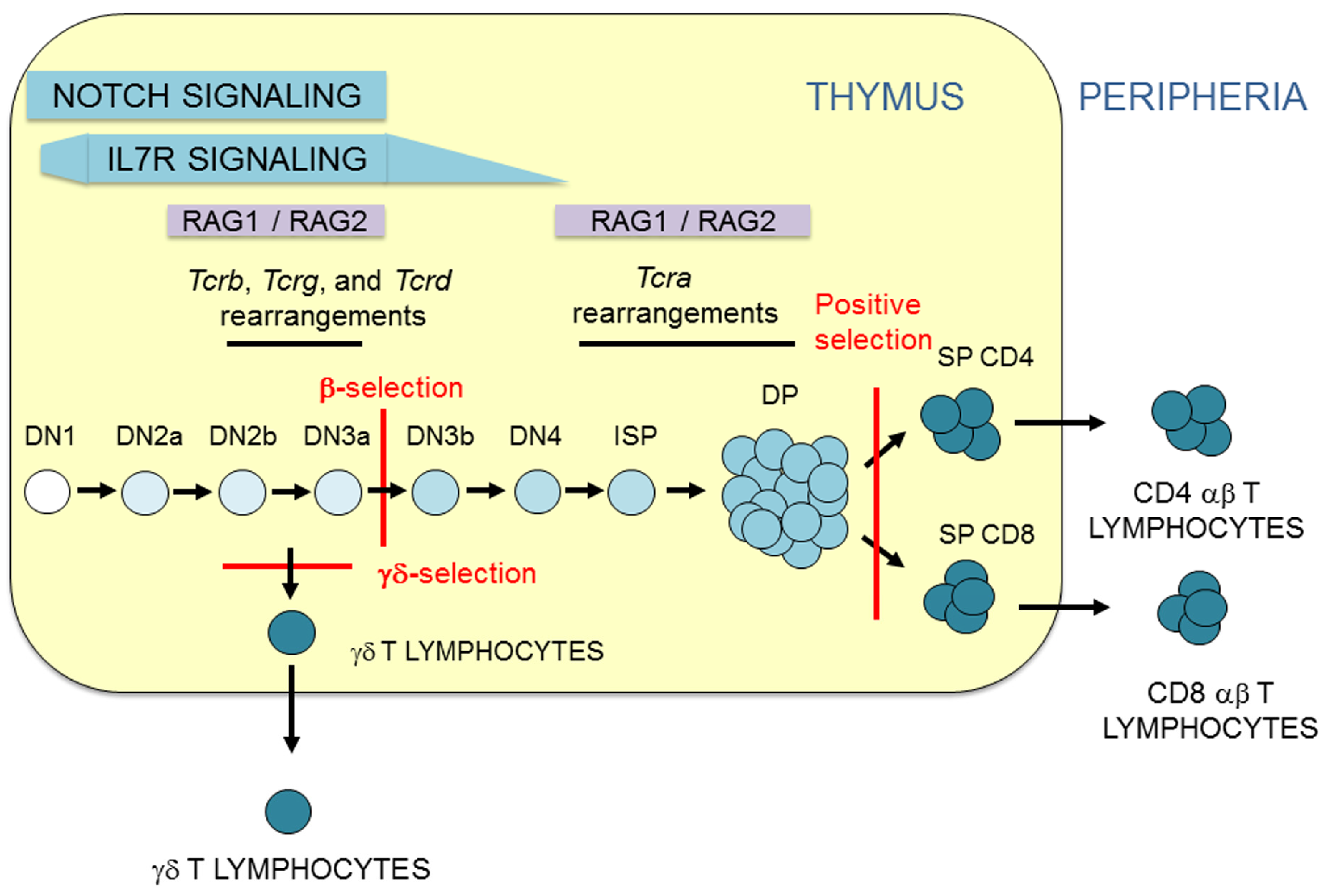
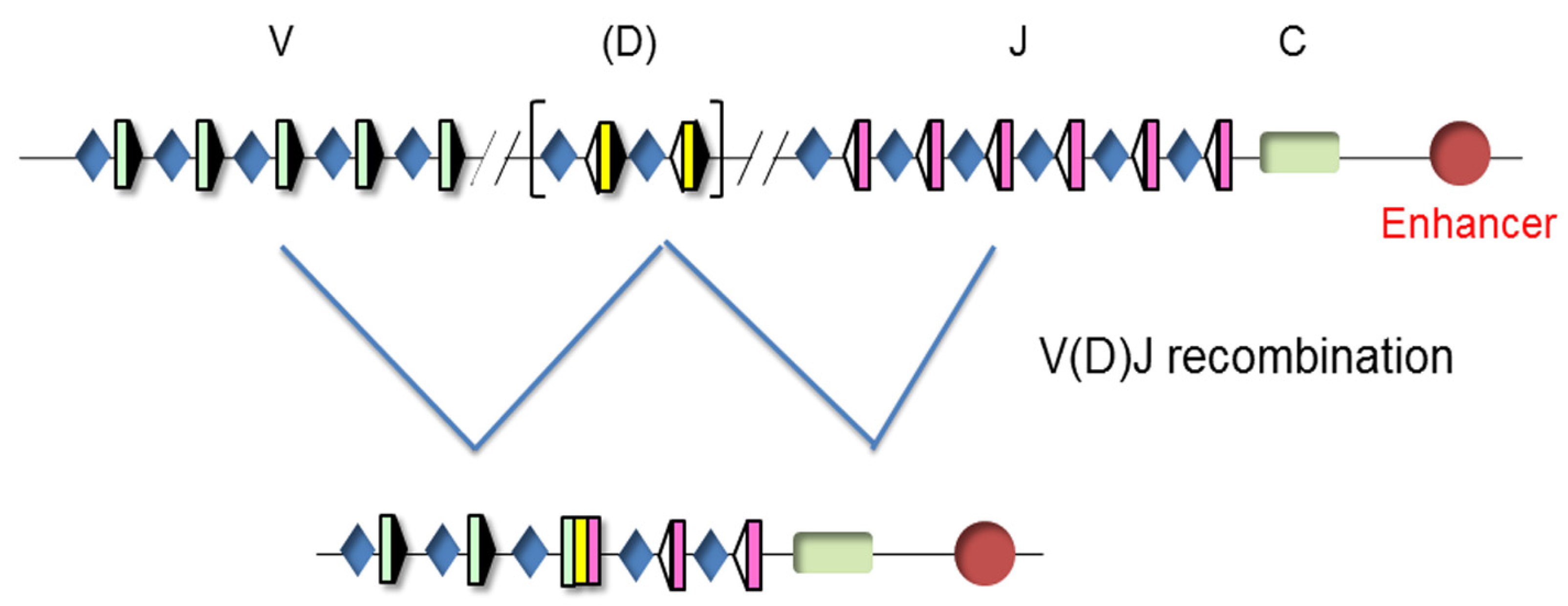
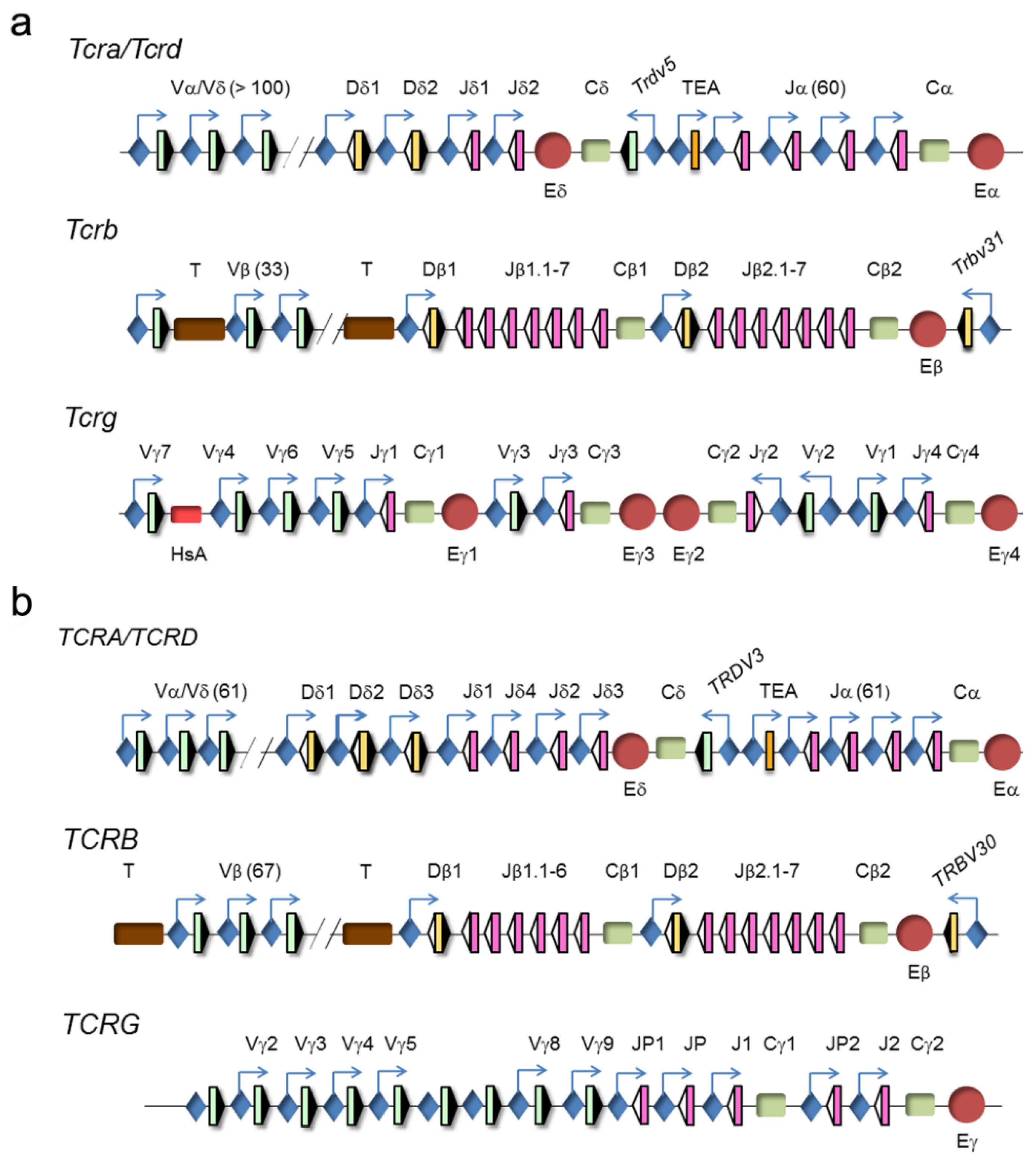
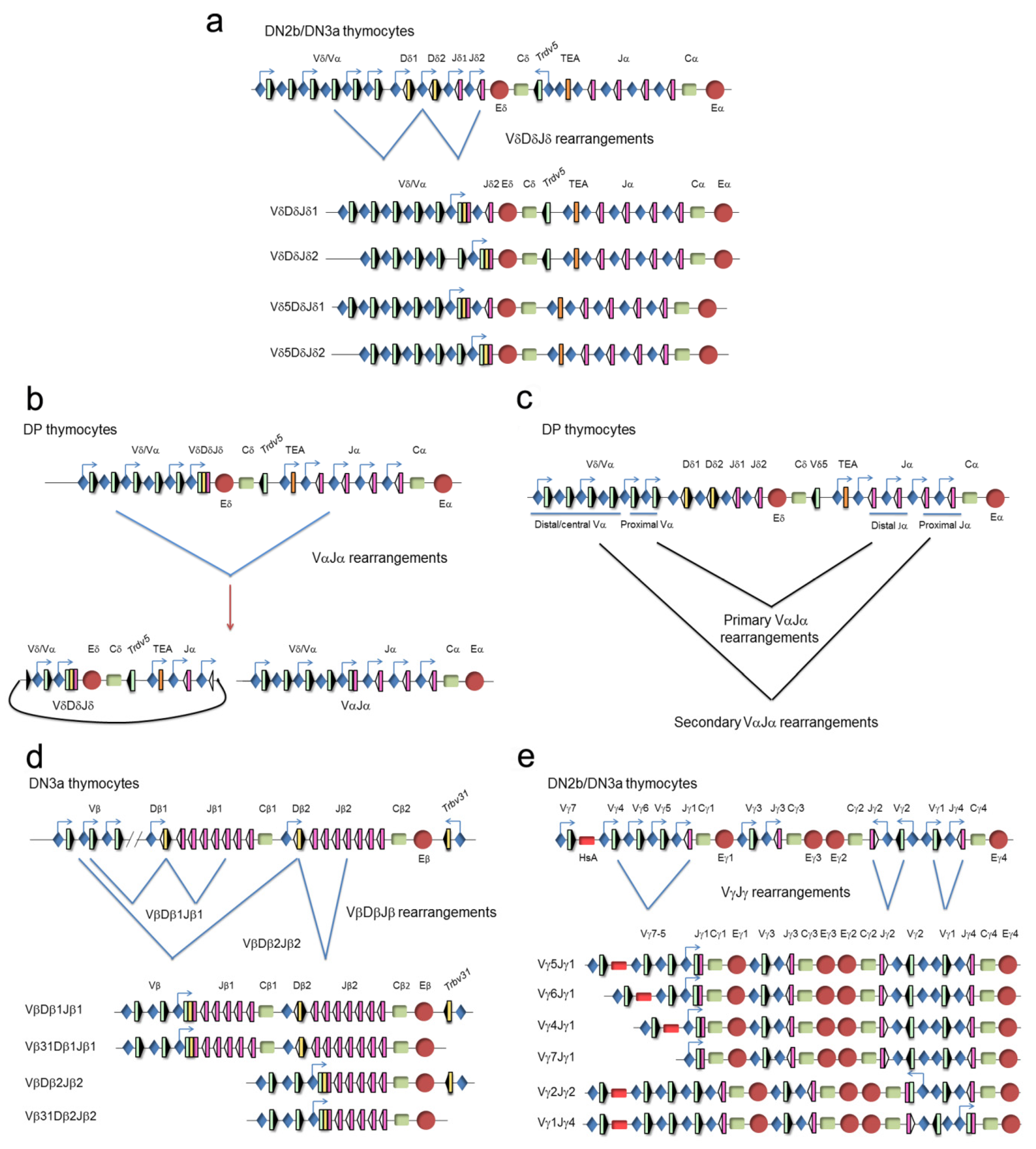
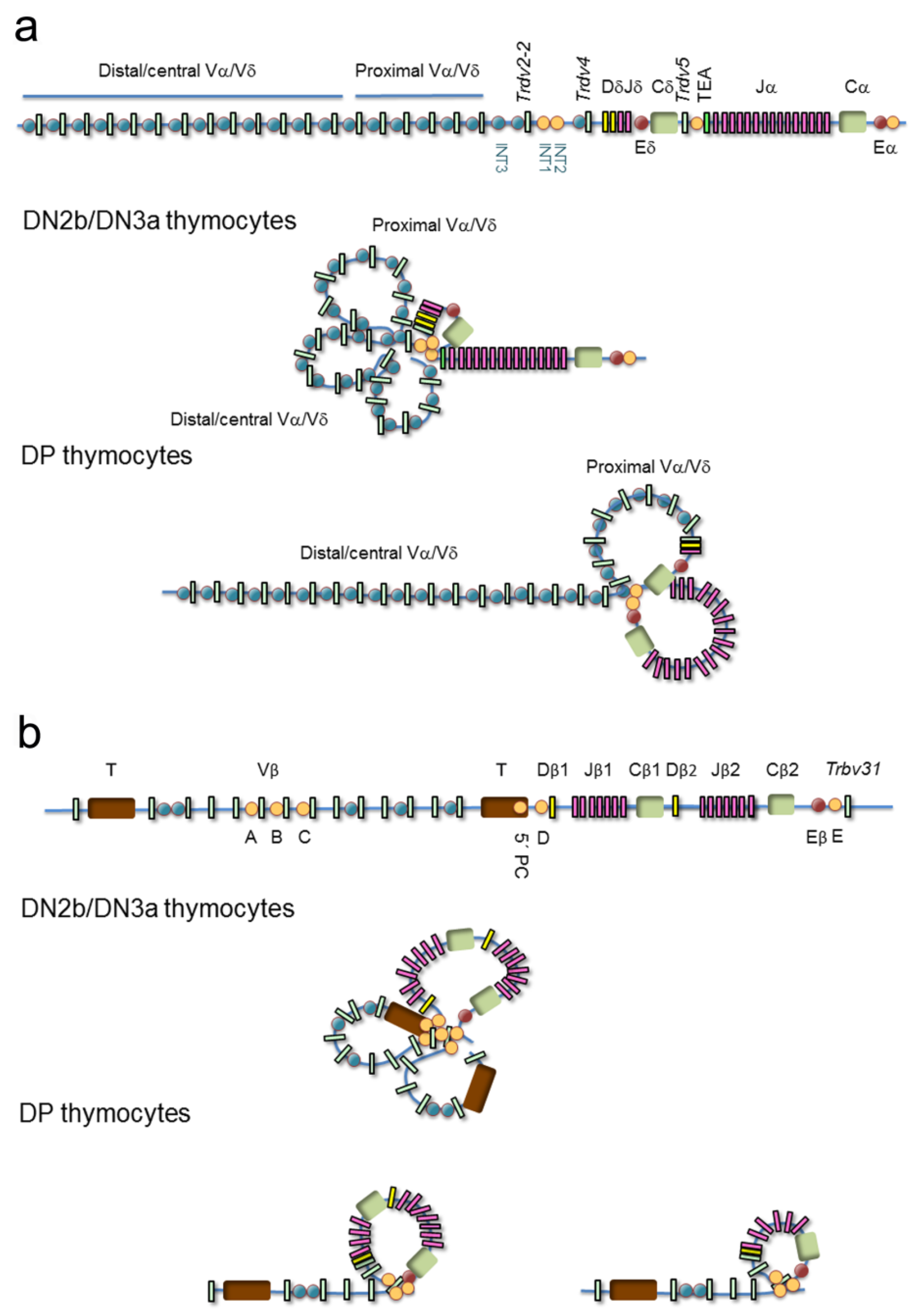
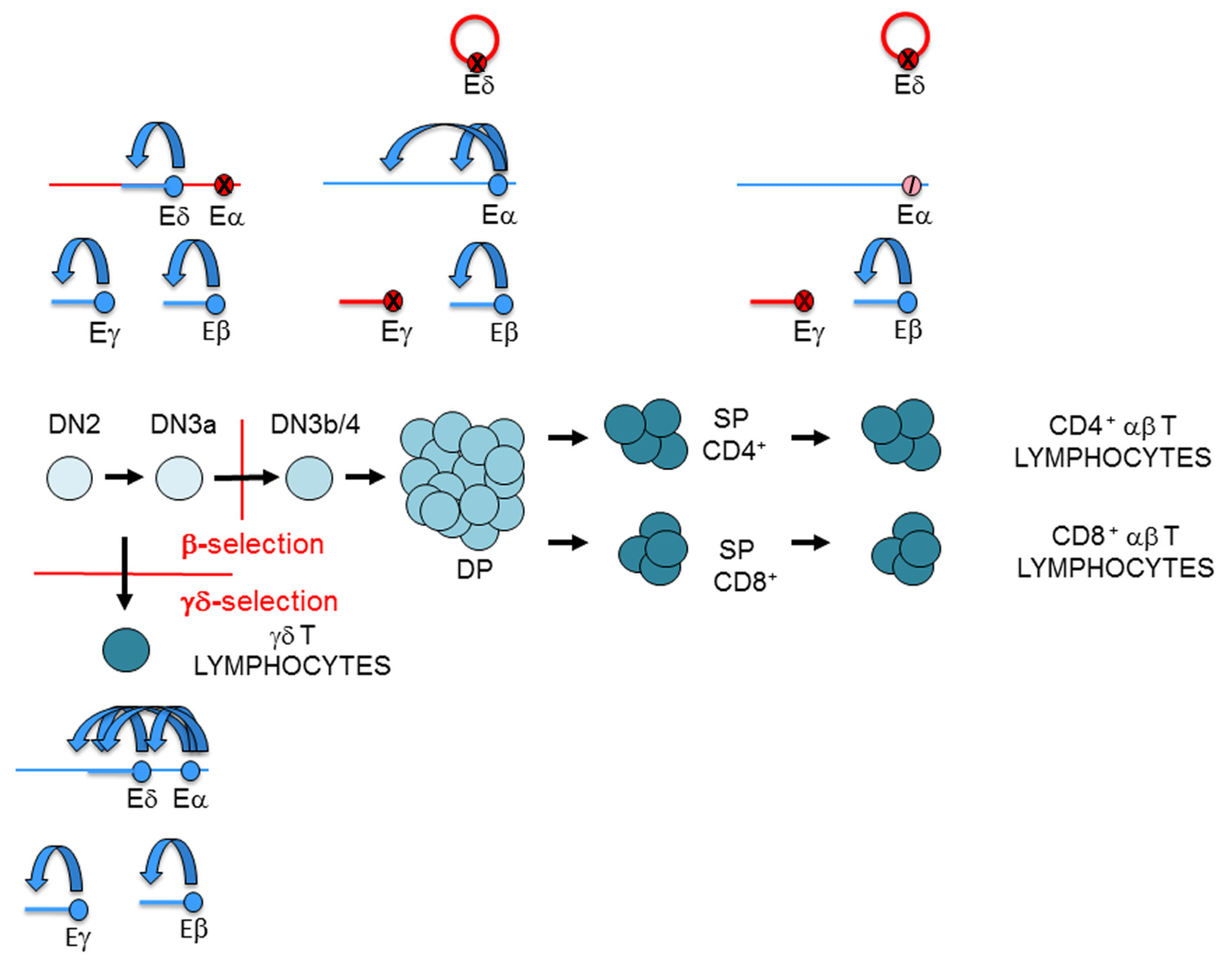

Publisher’s Note: MDPI stays neutral with regard to jurisdictional claims in published maps and institutional affiliations. |
© 2020 by the authors. Licensee MDPI, Basel, Switzerland. This article is an open access article distributed under the terms and conditions of the Creative Commons Attribution (CC BY) license (http://creativecommons.org/licenses/by/4.0/).
Share and Cite
Rodríguez-Caparrós, A.; Álvarez-Santiago, J.; del Valle-Pastor, M.J.; Suñé, C.; López-Ros, J.; Hernández-Munain, C. Regulation of T-cell Receptor Gene Expression by Three-Dimensional Locus Conformation and Enhancer Function. Int. J. Mol. Sci. 2020, 21, 8478. https://doi.org/10.3390/ijms21228478
Rodríguez-Caparrós A, Álvarez-Santiago J, del Valle-Pastor MJ, Suñé C, López-Ros J, Hernández-Munain C. Regulation of T-cell Receptor Gene Expression by Three-Dimensional Locus Conformation and Enhancer Function. International Journal of Molecular Sciences. 2020; 21(22):8478. https://doi.org/10.3390/ijms21228478
Chicago/Turabian StyleRodríguez-Caparrós, Alonso, Jesús Álvarez-Santiago, María Jesús del Valle-Pastor, Carlos Suñé, Jennifer López-Ros, and Cristina Hernández-Munain. 2020. "Regulation of T-cell Receptor Gene Expression by Three-Dimensional Locus Conformation and Enhancer Function" International Journal of Molecular Sciences 21, no. 22: 8478. https://doi.org/10.3390/ijms21228478
APA StyleRodríguez-Caparrós, A., Álvarez-Santiago, J., del Valle-Pastor, M. J., Suñé, C., López-Ros, J., & Hernández-Munain, C. (2020). Regulation of T-cell Receptor Gene Expression by Three-Dimensional Locus Conformation and Enhancer Function. International Journal of Molecular Sciences, 21(22), 8478. https://doi.org/10.3390/ijms21228478





